
Blikanasaurus
The ancient path to giant lineage.
Period
Triassic
Length
Estimated to be around 5 meters long.
Height
Stood approximately 3 meters tall.
Weight
Estimated to weigh around 1,000 kilograms.
Blikanasaurus was an early dinosaur from the Late Triassic period, characterized by its sturdy limbs and herbivorous diet. As a small-sized dinosaur, it provides valuable insights into the evolution of sauropodomorphs, a group that would eventually include the largest land animals. Its discovery in South Africa highlights the region's rich prehistoric biodiversity. The fossils give us glimpses into a time when early dinosaurs began to explore new ecological niches.
Diet
Blikanasaurus was herbivorous, feeding primarily on plants. Its teeth and jaw structure were adapted for processing tough vegetation, allowing it to thrive in lush environments.
Hunting
As a herbivore, Blikanasaurus did not hunt other animals. Instead, it foraged for plants, using its height to reach vegetation that others could not.
Environmental challenges
Blikanasaurus faced numerous environmental challenges, including periods of drought and fluctuating food availability. As it lived in a time of evolutionary diversification, it had to adapt to competing with other herbivores for resources. The changing climate of the Late Triassic likely played a significant role in shaping its habitat and migration patterns. Natural predators also posed a threat, and survival often depended on group living for protection.
Speed
Slow-moving due to its heavy build.
Lifespan
Potentially several decades, akin to modern reptiles.
First discovery
Discovered in South Africa during the late 20th century.
Fun Facts
- Blikanasaurus was a dinosaur from the late Triassic period that lived about 210 million years ago.
- It is known from only a few fossilized leg bones found in South Africa.
- The name Blikanasaurus means 'Blikana lizard,' named after the Blikana Mountain where its fossils were discovered.
- Blikanasaurus was a small to medium-sized dinosaur, likely a herbivore that walked on all fours.
- It is considered one of the earliest known sauropodomorphs, a group that eventually gave rise to the giant sauropods.
- Its fossils were first described in 1985 by paleontologists who identified it from leg bones.
- Despite limited fossil evidence, Blikanasaurus provides insight into the early evolution of dinosaurs.
Growth and Development
Blikanasaurus grew relatively slowly, reaching maturity over several years. Its development would have been influenced by environmental conditions such as food supply and climatic changes. Juveniles likely stayed close to adults for protection and guidance. Fossil evidence suggests that it underwent specific growth spurts in response to environmental pressures.
Habitat
Blikanasaurus inhabited riverbank environments, where vegetation was plentiful. These areas provided not only food but also safety from predators due to dense foliage. Seasonal flooding in its habitat would have created rich, nutrient-dense soils that supported diverse plant life. Its environment offered a mix of forested areas and open spaces, ideal for grazing.
Interaction with other species
Blikanasaurus coexisted with other early dinosaurs and prehistoric reptiles. It likely maintained a peaceful disposition, focusing on feeding and avoiding conflict. The presence of various herbivores in its environment suggests competition for food sources was common. It would have used its physical presence to assert dominance over smaller rivals when necessary.
Natural lifespan
Blikanasaurus had a natural lifespan of several decades.
Reproduction
Blikanasaurus likely laid eggs, as inferred from related species. Nesting behaviors might have included shallow pits dug in soft ground to protect its developing young. Parental care might have been limited, with the young born ready to fend for themselves. Clutch sizes were probably small, ensuring a higher investment per offspring.
Social behaviour
Blikanasaurus might have lived in small herds or family groups. This social structure would have provided safety and support for younger members. Interactions within the group included cooperative feeding and migration in search of food. The stability of these groups would have been vital for survival in a challenging environment.
Fossil locations
Fossils of Blikanasaurus have primarily been found in South Africa. These discoveries highlight the region's significance during the Triassic period. The sites provide crucial evidence for understanding the early diversification of dinosaurs. Ongoing excavations continue to reveal more about its distribution and ecology.
